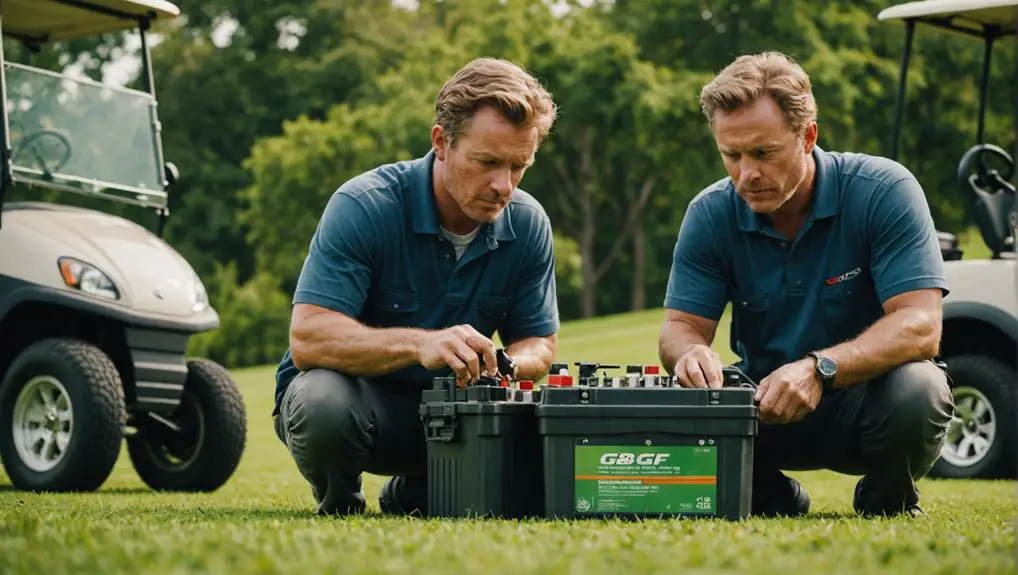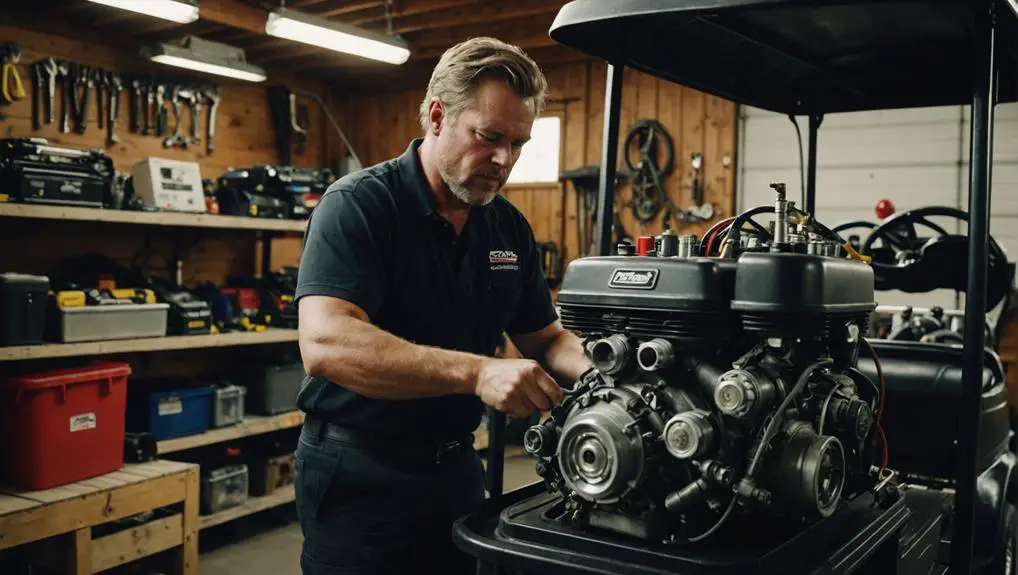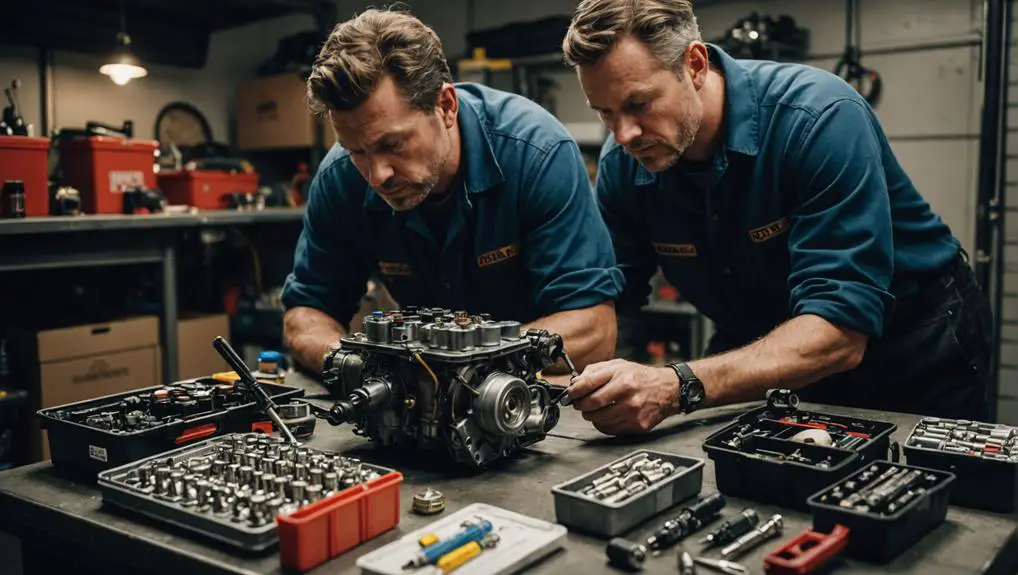Like a classic detective story, troubleshooting gas golf cart problems often leads you down a path of clues and revelations. You might find yourself grappling with starting issues, fuel supply concerns, or even electrical glitches that can leave you stranded on the course. Each symptom could be a hint pointing to a deeper issue that, once uncovered, can restore your cart's performance. So, what's the first step in this investigative journey? Let's explore the common culprits that could be affecting your golf cart's reliability.
Key Takeaways
- Check battery voltage and connections; a weak battery can hinder starting and performance in gas golf carts.
- Inspect the ignition system for faults, including the ignition switch and spark plugs, to ensure proper engine ignition.
- Verify fuel quality and supply, ensuring the tank has fresh fuel and fuel lines are clear of blockages.
- Examine the battery for corrosion and physical damage, and clean terminals to maintain optimal electrical connections.
- Regularly perform maintenance checks, including oil levels, air filter cleanliness, and brake system functionality, to enhance overall performance.
Starting Issues
Experiencing starting issues with your gas golf cart can be frustrating, but diagnosing the problem doesn't have to be complicated. Start by checking the battery. Verify it's charged and the connections are clean and tight. A weak battery can prevent the cart from starting, so test it with a multimeter to confirm it's delivering the right voltage.
Next, inspect the ignition system. Look for a faulty ignition switch or worn spark plugs. If the spark plugs are dirty or damaged, replace them to improve ignition efficiency. Additionally, make certain the ignition coil is functioning. You can test it with an ohmmeter to see if it's providing adequate voltage.
Fuel System Problems
When tackling fuel system problems in your gas golf cart, it's crucial to pinpoint the source of the issue quickly.
Start by checking the fuel tank; verify it's filled with fresh, clean fuel. Stale or contaminated fuel can cause starting issues and poor performance.
Next, inspect the fuel lines for leaks, cracks, or blockages. Any obstruction can hinder fuel flow, leading to sputtering or stalling.
Don't overlook the fuel filter; a clogged filter restricts fuel delivery to the engine. Replace it if it appears dirty or hasn't been changed in a while.
Additionally, check the fuel pump. Listen for a humming sound when you turn the ignition on; if it's silent, the pump may be faulty.
Lastly, assess the carburetor for debris or varnish buildup. Cleaning or rebuilding the carburetor can restore peak performance.
If you've gone through these steps and the issue persists, it might be time to consult a professional. Properly diagnosing and addressing fuel system problems can greatly enhance your golf cart's reliability and efficiency.
Battery Troubles

When you're facing battery troubles, the first thing you should check is the charge level.
Low battery voltage can prevent your golf cart from starting or running efficiently.
Additionally, corroded battery connections can disrupt the electrical flow, so inspect the terminals for any signs of corrosion.
Battery Charge Issues
Running into battery charge issues can be frustrating, especially if your gas golf cart suddenly loses power during a ride.
The first step in troubleshooting is to check the battery's voltage. Use a multimeter to measure the voltage across the terminals. A fully charged battery should read around 12.6 volts. If it's below 12.4 volts, you may have a weak battery that needs charging or replacement.
Next, inspect the battery itself for any signs of damage, such as cracks or leaks, which could indicate a failing battery. If your battery is old—typically over three years—it might be time for a replacement, regardless of its current charge.
Also, consider how often you use the cart. If you frequently leave it unused for long periods, the battery mightn't hold a charge effectively.
Regularly charging your battery can help maintain its health.
Corroded Battery Connections
Inspecting your gas golf cart for corroded battery connections is essential for ensuring peak performance. Corrosion can lead to poor conductivity, which affects the battery's ability to deliver power effectively.
To check for corrosion, start by turning off your cart and disconnecting the battery cables. Look for a white, ashy substance or greenish-blue deposits around the terminals—this indicates corrosion.
If you find corrosion, use a mixture of baking soda and water to clean the terminals. Apply the solution with a toothbrush, scrubbing gently to remove the buildup. Rinse with clean water and dry the terminals thoroughly.
After that, reconnect the battery cables, ensuring they're tight and secure.
Regular maintenance can prevent future corrosion. Consider applying a protective spray or grease designed for battery terminals to create a barrier against moisture and corrosion.
It's also a good practice to inspect the connections periodically, especially if you notice any performance issues with your cart. By taking these steps, you'll enhance your gas golf cart's reliability and longevity, ensuring a smoother ride every time you hit the road.
Ignition System Failures
Ignition system failures can lead to frustrating experiences when trying to start your gas golf cart. When you turn the key and nothing happens, it's crucial to diagnose the issue effectively.
Several components can contribute to ignition failure, so you'll want to check the following:
- Ignition Switch: Confirm it's functioning properly; a faulty switch can prevent power from reaching the ignition system.
- Spark Plug: Inspect the spark plug for wear or carbon buildup, as these can hinder ignition.
- Ignition Coil: Test the ignition coil for continuity and output. A defective coil won't generate the necessary spark.
- Wiring: Look for damaged or loose wires connecting the ignition components. Poor connections can disrupt the entire system.
- Fuel Supply: Verify that fuel is reaching the engine; a lack of fuel can mimic ignition problems.
Engine Performance Issues

Engine performance issues can considerably affect your gas golf cart's overall functionality and enjoyment. If you notice a decrease in power, rough idling, or stalling, it's vital to diagnose the problem promptly.
Start by checking the fuel system. Confirm you have clean fuel and that the fuel filter isn't clogged. Old or contaminated fuel can lead to poor combustion, so consider draining and replacing it if it's been sitting for a while.
Next, inspect the air filter. A dirty or blocked air filter restricts airflow, resulting in a lean mixture that can cause performance issues. Clean or replace the filter as needed.
Another area to investigate is the carburetor. If it's dirty or misadjusted, it can lead to improper fuel delivery. Cleaning the carburetor and adjusting its settings might resolve your performance issues.
Lastly, check for any exhaust obstructions, as a blocked exhaust can hinder engine breathing, causing sluggish performance.
Electrical System Glitches
When troubleshooting electrical system glitches in your gas golf cart, start by examining battery connections for corrosion or looseness, as these can disrupt power flow.
Next, inspect wiring components for any signs of wear or damage that could lead to shorts or interruptions.
Battery Connection Issues
Battery connection issues can lead to frustrating electrical system glitches in your gas golf cart. These problems often stem from loose, corroded, or damaged connections, which can interrupt the power flow necessary for proper operation.
To diagnose and resolve these issues, follow these steps:
- Inspect battery terminals: Check for corrosion or dirt that could interfere with connections.
- Tighten loose connections: Verify all battery cables are securely attached to the terminals.
- Look for frayed wires: Examine cables for any wear or damage that might cause intermittent connections.
- Clean connections: Use a wire brush or a battery terminal cleaner to remove corrosion from terminals and connectors.
- Check voltage levels: Use a multimeter to measure battery voltage, verifying it meets the manufacturer's specifications.
Faulty Wiring Components
Faulty wiring components can create significant electrical system glitches in your gas golf cart, leading to unreliable performance or complete operational failure.
When you experience issues, start by inspecting the wiring harness for any visible signs of damage such as fraying, corrosion, or loose connections. These problems can disrupt the flow of electricity, causing intermittent functionality or complete failure of electrical systems.
Pay close attention to connectors and terminals, as they often suffer from wear and tear. Loose or corroded connections can lead to voltage drops, affecting the performance of your cart. If you find any issues, clean the terminals with a wire brush and guarantee a secure fit.
Additionally, check for pinched or exposed wires, especially in areas where the harness makes contact with metal surfaces. This contact can cause shorts, which may lead to blown fuses or damaged components.
It's also wise to test the continuity of the wiring using a multimeter, guaranteeing there are no breaks in the circuit.
Lastly, if you're uncomfortable diagnosing electrical issues, consider consulting a professional to avoid further complications. Keeping your wiring in good condition is essential for reliable operation.
Solenoid Malfunctions
Solenoid malfunctions often lead to frustrating electrical system glitches in gas golf carts. When your solenoid isn't functioning correctly, it can prevent your cart from starting or cause intermittent power issues. Understanding the signs of solenoid failure can save you time and money in troubleshooting.
Here are some common symptoms of solenoid malfunctions:
- No Start: The engine won't crank when you turn the key.
- Clicking Sound: You hear a clicking noise but no engine engagement.
- Intermittent Power: The cart powers on and off unexpectedly.
- Burnt Smell: You notice a burning odor near the electrical components.
- Corrosion: Visible rust or corrosion on the solenoid terminals.
To diagnose the issue, check the battery connections, ensuring they're clean and tight.
Next, measure voltage at the solenoid with a multimeter. If the voltage is present but the solenoid doesn't activate, it's likely faulty.
Replacing the solenoid is usually straightforward, but make sure to disconnect the battery first to avoid electrical shocks.
Maintenance Tips

Regular maintenance is vital for keeping your gas golf cart running smoothly and efficiently. Start by checking the oil levels regularly; it's essential for the engine's performance. Change the oil and filter according to the manufacturer's recommendations, typically every 100 hours of operation.
Next, inspect the air filter. A clean air filter guarantees ideal airflow to the engine, improving performance. Replace it if it's dirty or clogged.
Don't forget to check the fuel system. Look for leaks in the fuel lines and verify the fuel filter is clean. Also, make certain you're using fresh fuel, as old gas can cause starting issues.
Inspect the battery terminals for corrosion and confirm they're tight. Clean them as needed.
Finally, examine the tires for proper inflation and tread wear. Under-inflated or worn tires can affect handling and fuel efficiency.
Regularly check the brake system, too. This guarantees safe operation and helps prevent costly repairs.
Frequently Asked Questions
How Often Should I Change the Oil in My Gas Golf Cart?
You should change the oil in your gas golf cart every 100 hours of operation or at least once a year, whichever comes first.
Regular oil changes keep the engine running smoothly and extend its life. Always use the manufacturer-recommended oil type for peak performance.
Check the oil level regularly, too; if it looks dark or gritty, it's time for a change. Staying on top of maintenance guarantees your golf cart operates efficiently.
What Type of Fuel Is Best for My Gas Golf Cart?
For your gas golf cart, using high-quality unleaded gasoline with a minimum octane rating of 87 is best.
Avoid ethanol blends over 10%, as they can cause fuel system issues.
Regularly check for water or debris in your fuel, as cleanliness is essential for peak performance.
You should also consider adding a fuel stabilizer to prevent degradation, especially if you won't be using the cart for an extended period.
Can Weather Affect My Golf Cart's Performance?
Yes, weather can greatly affect your golf cart's performance.
Extreme temperatures can impact engine efficiency and fuel combustion. Cold weather may make starting difficult, while high heat can cause overheating.
Humidity levels can also affect air intake and engine performance.
You should always check the oil and battery, as they can be more susceptible to temperature fluctuations.
Regular maintenance helps guarantee your cart runs smoothly, regardless of the weather conditions.
How Can I Improve My Gas Golf Cart's Fuel Efficiency?
To improve your gas golf cart's fuel efficiency, start by maintaining proper tire pressure; under-inflated tires can increase drag.
Regularly clean or replace the air filter to guarantee ideal airflow.
Use high-quality fuel and consider adding a fuel additive designed for efficiency.
Limit unnecessary weight by removing excess items from the cart, and drive smoothly, avoiding rapid acceleration and hard braking.
Regular maintenance checks will also keep your engine running efficiently.
Are There Any Specific Storage Tips for Gas Golf Carts?
When storing your gas golf cart, it's essential to prepare it properly.
First, clean it thoroughly to prevent corrosion.
Next, fill the fuel tank to minimize moisture buildup and add a fuel stabilizer.
Disconnect the battery and store it in a cool, dry place.
Keep the cart covered to protect it from dust and UV damage.
Finally, check tire pressure before storage to avoid flat spots.
Following these steps will guarantee your cart stays in top condition.
Conclusion
In the world of gas golf carts, smooth rides hinge on understanding and addressing common issues. Picture yourself gliding effortlessly across the course, free from the frustration of starting troubles or sputtering engines. By routinely checking your fuel system, battery, ignition, and electrical components, you'll guarantee your cart runs like a well-oiled machine. Embrace regular maintenance, and you'll not only enhance performance but also enjoy countless rounds without a hitch, leaving worries in the dust behind you.